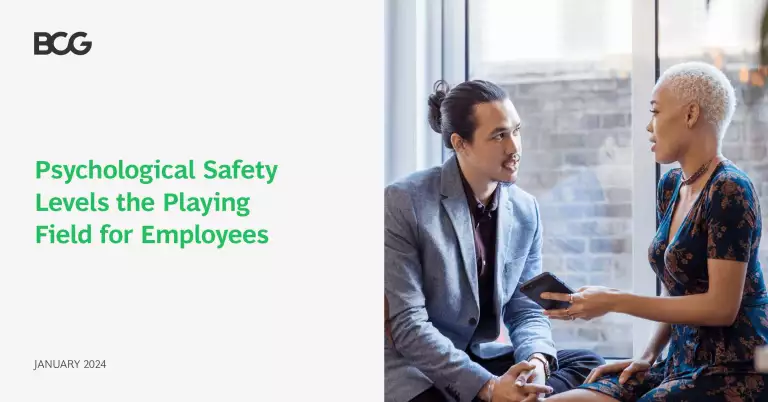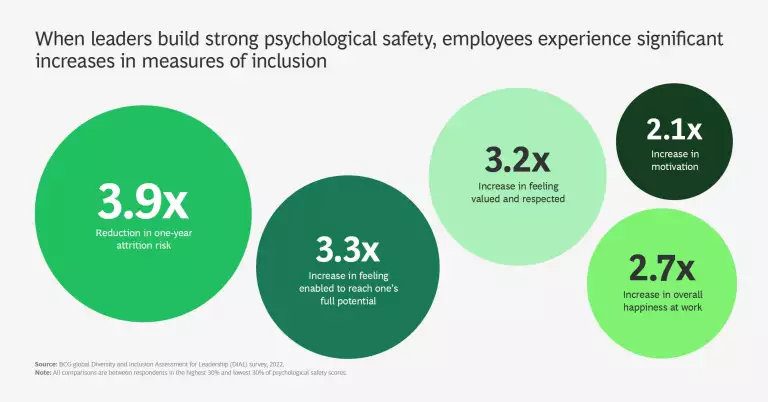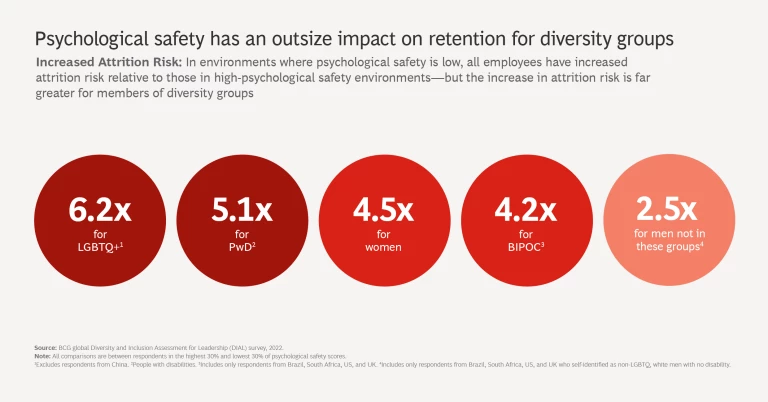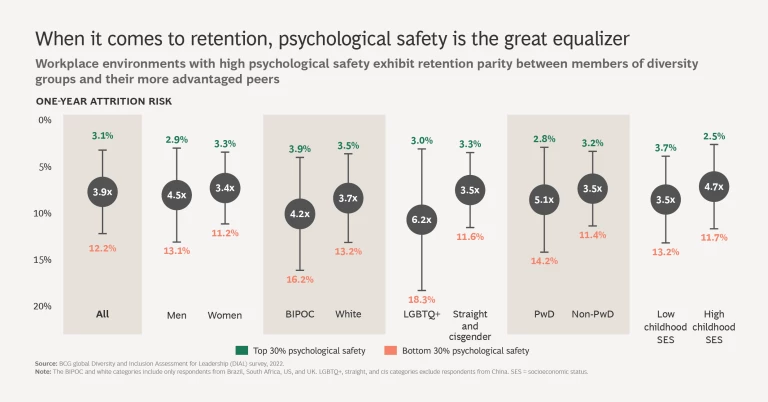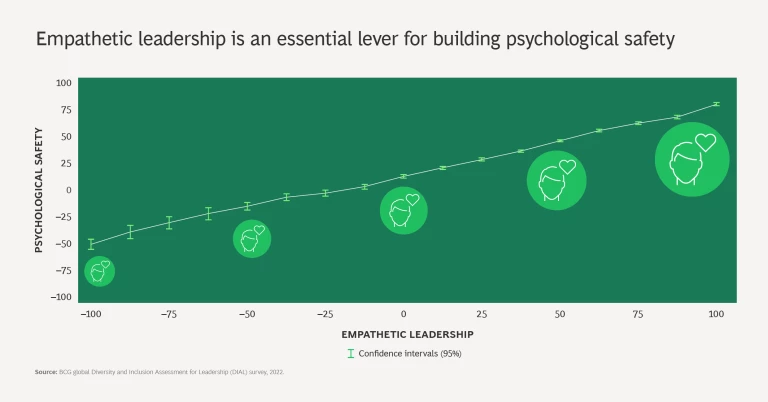The need to create psychological safety in the workplace has never been more urgent. A decade ago, Google’s Project Aristotle famously found that psychological safety is the top driver of team success for all employees. New BCG research shows that it is also particularly effective at improving the workplace and reducing attrition for women, people of color, LGBTQ+ employees, people with disabilities, and people from economically disadvantaged backgrounds.
Psychological safety effectively functions as an equalizer—enabling diverse and disadvantaged employee groups to achieve the same levels of workplace satisfaction as their more advantaged colleagues. (See “About Our Research.”)
About Our Research
So how can organizations create a psychologically safe work environment? It all comes down to empathetic leadership. Empathetic leaders approach their teams with a mindset of openness, growth, and authenticity while setting up systems at their companies to embed psychological safety into everyday team practices. Psychological safety does not mean that employees don’t need to perform at a high level—in fact, we find that in a psychologically safe environment, employees are more motivated and more ambitious.
With empathetic leadership, organizations can finally unlock the full value of their diversity, equity, and inclusion ambitions by increasing employee happiness and motivation, boosting team innovation and creativity, and eliminating the disproportionate risk of attrition among diverse employee groups.
Explore Further Insights on Psychological Safety
A Conversation with Joe Davis Do Not Stop Asking Questions and Listening Carefully to the Answers | A Conversation with Dinesh Khanna Psychological Safety Is a Critical Foundation for Good Team Management | A Conversation with Ulrike Schwarz-Runer |
What Psychological Safety Is—and Isn’t
Psychological safety is the shared belief that it is safe to speak up in the workplace and take risks without fear of being blamed or criticized. In a group work setting, employees who feel psychologically safe are more likely to test the status quo, admit mistakes, view failure as a growth opportunity, and be their authentic selves.
However, psychological safety shouldn’t be interpreted as a license to bring to the workplace views or opinions that may damage others’ psychological safety and feelings of inclusion. Achieving this delicate balance requires a mix of policies and guidelines, leadership role modeling, and a culture built on respect and empathy.
But some common myths about psychological safety persist:
- You have to avoid conflict. Not true. When employees are unwilling to express dissent, it’s a sign that your team isn’t psychologically safe. It means people are reluctant to voice their genuine concerns. When team members do feel safe, they raise problems, debate ideas, and share openly because they aren’t afraid of being penalized for speaking up. All this, of course, within the context of respect for colleagues and their psychological safety.
- Performance will suffer because you’re coddling people. Psychological safety doesn’t mean overlooking poor performance. It means giving direct feedback so that people can learn from their mistakes—in a discussion that frames the issue as an opportunity for growth, not a sign of failure.
- Every team member is equally responsible for the team’s psychological safety. Although collective buy-in is important, leaders still have an outsize impact. They set the tone by being role models and signaling what behaviors will be rewarded and what won’t be tolerated. Psychological safety can flourish only if it’s driven by leaders.
- Only struggling teams need it. All teams benefit from psychological safety because it gives them the power to be more creative and to focus on learning.
What the Data Shows
When leaders use empathy to build psychological safety, their employees experience positive outcomes: significant increases in motivation and happiness, feeling valued and respected, and feeling enabled to reach their full potential—all of which improve feelings of inclusion, a key lever for attracting and retaining talent.
Empathetic leaders create a safe working environment, support employees when things get tough, and show respect for the perspectives, emotions, and life situations of team members. They value the feelings and experiences of others and recognize how these might vary depending on cultural background, race, or ethnicity; LGBTQ+ identity; health conditions, disability, or neurodiversity; caregiver status; and more.
When empathetic leaders build a culture of psychological safety, our data shows, retention risk is reduced. Twelve percent of employees with the lowest levels of psychological safety said they were likely to quit within a year. But when psychological safety is high, only 3% of employees are at risk of quitting.
The positive effects of psychological safety are particularly pronounced among women, people of color, LGBTQ+ employees, people with disabilities, and people from economically disadvantaged backgrounds. Our data shows that members of diverse and disadvantaged employee groups say they are much more likely to quit when in workplace environments with low psychological safety as compared with their more advantaged peers in the same environment.
Consider these findings. When leaders successfully create psychological safety at work, retention increases by more than four times for women and for employees who identify as Black, Indigenous, or people of color (BIPOC); by five times for people with disabilities; and by six times for LGBTQ+ employees. This is compared with an increase of two times in retention for men not in those groups (that is, white, non-LGBTQ+ men with no disability).
In short, improving psychological safety drives positive outcomes for all employees but delivers outsize gains for diverse employee groups. It is the equalizer that brings employees of all backgrounds up to the same high-water mark of happiness at work—and erases the attrition gap.
When psychological safety is lacking, on the other hand, members of diversity groups have a higher risk of attrition relative to other employees. For example, 18% of LGBTQ+ employees in the bottom 30% of the psychological safety spectrum are at risk of attrition, compared with just 12% of straight and cisgender employees. But for those in the top 30% of psychological safety, attrition risk gap between groups narrows, resulting in a low (3%) attrition risk for all.
Our research shows a direct and powerful relationship between empathetic leadership and feelings of psychological safety in the workforce, giving leaders a clear directive to be empathetic and thereby engender psychological safety. This in turn delivers key workplace benefits to both the organization and its employees.
What Empathetic Leaders Do
Leaders have the influence to ensure that team members feel safe, supported, and understood. It starts with empathy. Here’s how.
Formalize time for sharing and learning. At the start of meetings, carve out a few minutes for team members to share something new they’ve learned, an activity from their weekend, or something personal from their life. This lets people engage with one another as humans first, before diving into content. Importantly, as the leader, feel free to share your own successes and challenges—research has shown that when leaders are vulnerable, it sets the tone for psychological safety in a team.
Hold regular team reflections or “retrospectives.” Provide opportunities to reflect on how the team is doing. Participants can share thoughts on what’s going well and suggest ways to improve the work environment for the whole team.
Be open and authentic. Candidly share your own mistakes and lessons learned with the team. Leaders don’t have all the answers, and being open about that empowers team members to share their own ideas without fear of judgment or embarrassment.
Challenge ideas, not people. When delivering feedback, make sure that any criticism focuses on the substance of the work, not the person who did the work: focus on opportunities to improve the content. Acknowledge employees for their contributions to the process, even when they don’t land on the perfect idea or output on the first try.
Address problems directly. Employees need to feel safe questioning ideas, policies, and practices, even if this creates a certain amount of conflict or disagreement. By fostering a culture of productive disagreement and debate, you can encourage deeper levels of understanding and trust and deal with issues before they escalate.
Consider cultural context. Your employees may come from different cultures, and not everyone has the same comfort level when it comes to sharing their thoughts and feelings. You can’t force others to be open with you—and you shouldn’t try. Instead, create space for them to share if and when they’re ready.
Although companies are making well-intentioned efforts to recruit and hire a diverse workforce, many of those hires don’t thrive within the organization because they don’t feel included as valued, appreciated contributors. Fostering psychological safety takes work, and it will be difficult at times. Leaders must seek out diverse perspectives, actively listen, and conscientiously address any tensions that may arise. But the effort pays big dividends.
By using empathetic leadership to create a sense of psychological safety in the workplace, companies build stronger teams that can harness the creativity and insights that come from diverse voices and perspectives. And, in so doing, they can increase companies’ innovation, boost financial performance, and, at long last, make good on the promise of building fair, equitable, and inclusive workplaces.
We are grateful to the BCG coaching and teaming experts who shared their expertise for this report: Victoria Brough, Francesco Ferretti, Rekha Kent, Ethel Khoo, Rachel Levy, Dena Paris, and Timmie Wang. We also thank Dan Singer, Kayla McGrady, and Clarissa Touchstone for their contributions to the research.

